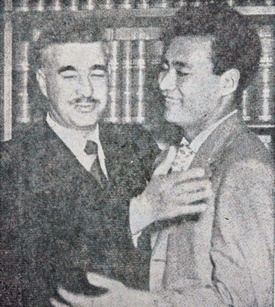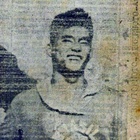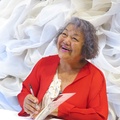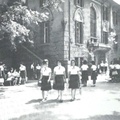In the documentary film "O nadador – A história de Tetsuo Okamoto" (hereafter abbreviated as "Swimming Athlete", 2014, 26 minutes, Portuguese, directed by Rodrigo Gullotta), which summarizes Okamoto's achievements and personality, his sister Suzue says that her brother's personality was "very modest and not very sociable. He was more devoted to sports than to studying." This personality may have been a factor in why he was not well known in the colonia.
Toninho Neto, a childhood friend of Tetsuo's in Marilia, also said, "Tetsuo had a big head and a thin body, so he was nicknamed Tacinha (Little Trophy)" (from the same film).

In 1950, Okamoto was not noticed in Colonia. At that time, a Japanese swimming delegation advised him, "If you want to achieve good results, you need to increase the amount of practice." Until then, he had only practiced 1,000 meters a day, but they advised him to swim 10,000 meters every day, and he faithfully followed the advice (Nikkei Shimbun, mentioned above).
In his obituary published in the October 3, 2007 issue of Folha de S. Paulo, it was written, "At the time, there were no heated swimming pools, so he fought the cold and completed his daily quota of 10,000 meters, his eyes reddening from the chlorine. He was almost fanatical." But that changed his life.
In the "Japanese Olympian Spirits" series on the Japan Olympic Committee website, Furuhashi writes that during his active career, "it was not uncommon for him to practice 20,000 meters a day," meaning he swam twice as much as Okamoto. The results of his intense training led to his new world record.
The results of Okamoto's intensive training were immediately apparent, and he began to stand out from the following year onwards. He won the 400m and 1500m freestyle at the Pan-American Games held in Buenos Aires, Argentina from late February to early March in 1951.
Okamoto became the first Brazilian to win a Pan-American tournament. At the same time, Brazil had narrowly lost to Uruguay in the final of the first FIFA World Cup held in Brazil (June-July 1950). It had been six months since the shock and Brazil had not yet recovered. At that time, Okamoto, who came first in the Americas, played a role in healing the trauma.
The city of Marília declared a national holiday and had Okamoto take part in a victory parade through the town in an open car, causing a frenzy among the townsfolk. However, during the parade, a burglar broke into Okamoto's house and stole his valuables, which was an added bonus episode typical of the local area.
The Japanese community in Marilia was delighted and offered to give Okamoto a car as a gift, but he refused, because he thought, "Olympic athletes must be amateurs. If I received something that could be mistaken for a prize, I would lose my amateur status."
It was a very different time than today when professional athletes participate.
Overcoming the Southern Hemisphere Handicap
June and July 1952 was a cold winter. The pool in Marilia where she practiced was so cold that she sometimes had to give up training. It was not an ideal Olympic preparation, and at one point she even considered giving up and saying, "I'd be happy if I could just participate."
Incidentally, the 2016 Rio Olympics will be the 31st modern Olympic Games and the first to be held in South America. Prior to that, the only Olympics held in the Southern Hemisphere were the Sydney Games in 2000. As such, the Olympics are held mostly in the Northern Hemisphere, so they are held in July and August. Even though they are the "Summer Olympics," they are held in the middle of winter in the Southern Hemisphere, and at the time, when heated pools were not as common as they are today, this was a big handicap.
But Okamoto did not give up. There are many interesting testimonies in the movie "Swimming." For example, Ilo da Fonseca, a member of the same swimming team at the Helsinki Olympics, gives the following testimony.
The last training camp was at a pool in Guanabara, Rio. "We practiced there together. When I say 'together', it's actually a little different. We swam 800-1,000 meters each time. He would wait for that to finish and then start swimming silently by himself. I snuck a peek to see what he was doing, and he'd swam 4,000-5,000 meters in one go with no break, and I thought he was crazy. And he did it twice a day. Apparently it was a training method directly taught to him by the Japanese swimming team," he recalls with an astonished look on his face.
Unlike Sao Paulo, Rio is warm even in winter. I swam as hard as I could, trying to make up for the lost time I had lost.
In Helsinki, he experienced a heated pool (about 27 degrees) for the first time in his life and was impressed, saying, "This is wonderful." In the August 13, 1952 edition of the Paulista Newspaper, his mother Tsuyoka wrote that she had received a letter from her son in Helsinki saying, "I practice every day, and I'll do my best until the end in the 1,500-yen race." As he had said, the result of his perseverance until the end was the bronze medal of his dreams.
The paper also included a comment from his sister, who said, "I was a bit surprised that Tetsuo came in third place. I thought fifth or sixth place would be good, but third place was the best. It was the first time he had borne the Brazilian flag on the water, and I was so overwhelmed by the words of congratulations he received from everyone at the Yara Club, as well as from Tetsuo's friends and acquaintances, especially the Brazilians."
Interestingly, the August 3, 1952 edition of the Paulista newspaper reported the team's third place result in a modest three-column article rather than the headline coverage that many Brazilian newspapers gave them.
By the way, the top story of the day in the PA newspaper was "Makako Incident". It shows that it was a time when the aftereffects of winning and losing were still strong. The next story is the behind-the-scenes story of the production of a film on immigration history. This is also related to winning and losing.
First place winner Konno Ford was born in Hawaii in 1933 and was an accomplished swimmer at McKinley High School in Honolulu and Ohio State University. He was a hero in the American swimming world, winning three medals in total, two gold and one silver, at the 1952 Helsinki Olympics, and another silver at the next Melbourne Olympics (1956).
There must have been a lot of emotion in Okamoto's heart as he stood on the podium, competing with Hashizume, who had been part of the visiting team that had excited the whole of Brazil just two years earlier in 1950.
However, the all-important "Flying Fish of Fujiyama" himself, Furuhashi Hironoshin, had contracted amoebic dysentery during his trip to South America, which affected his performance and he only managed to place eighth in the 400m freestyle at the Helsinki event.
The online edition of the June 7, 2011 edition of the Nikkan Sports newspaper wrote about Furuhashi: "The national hero who broke world records 33 times and became a symbol of postwar reconstruction ended up retiring without winning a single Olympic medal. One factor was the amoebic dysentery he contracted during his tour of South America in 1950. He competed in 20 games in 45 days, like a circus. He was welcomed by Japanese people in various countries, and the "face" of Japan's swimming team was not allowed to take a break." From the local perspective, this may seem a bit like a satire.
*This article is reprinted from the Nikkei Shimbun (August 20th and 25th , 2016 ).
© 2016 Masayuki Fukasawa, Nikkey Shimbun






